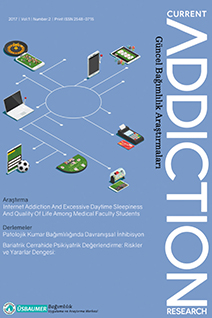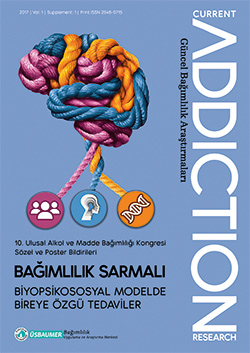ARTICLES
Case Report
“TILL PETHIDINE DO US APART”; ADDICTED HEALTHCARE PROFESSIONAL COUPLE
Alptekin Çetin,Ahmet Yılmaz,Cemal Onur Noyan
2017, 1(2), s:75-77
Pethidine(Meperidine) is a synthetic opioid analgesic of the phenylpiperidine class. Since 1940ies, addictive potential of pethidine was documented in many reports. Pethidine addiction is also common among medical doctors and nurses. We present clinical features and treatment response of a married couple, a gastroenterologist and a nurse who were admitted with pethidine addiction. A 34-year-old male(a gastroenterologist) and a 26-year-old female(a nurse) married couple were admitted to clinic with the use of pethidine intravenously. While male patient refused treatment, female patient continued her treatment in inpatient service. Healthcare professionals have to be cautious while using and prescribing drugs with addiction potential. Surgeons, anesthesiologists, gastroenterologists psychiatrists and surgical nurses are the risk groups for dependency among those professionals.
Original Article
Zeynep Ülke,Cemal Onur Noyan,Nesrin Dilbaz
2017, 1(1), s:16-25
Objective: The objective of this study was to adapt the “Bergen Facebook Addiction Scale (BFAS)” developed by Adreassen et al (1) into Turkish, and to evaluate the reliability and validity of the Turkish version of the Bergen Facebook Addiction among university students.
Method: The study was conducted in 2015 at Uskudar University and Yeditepe University (Istanbul-Turkey) with a total of 300 students from different majors and age groups. The draft scale was finalized after being translated and corrected by experts in the relevant fields. To determine the validity of the scale; factor analysis was performed and the results revealed that, of the 6 items reflecting the six core elements. It was detected that all items were distinctive with respect to relationship of each item with its related factor. Reliability level was determined by test – retest and internal consistency analysis. In addition, to test the criterion dependence validity of the scale, the correlation between the data gathered from Bergen Facebook Addiction Scale was analyzed respectively with data collected from the Smartphone Addiction Scale, Facebook Use Variance and Facebook Addiction Self-evaluation.
Results: The internal consistency coefficient was calculated using the Cronbach’s Alpha formula and gave a result of crα= .89. The 3-week test-retest validity Cronbach’s alpha was .76 for the six-item Bergen Facebook Addiction Scale. The factor analysis and testretest results confirmed the reliability and validity of the 6-item scale.
Conclusion: Bergen Facebook Addiction Scale is able to measure reliably, and the scale is a valid and reliable tool to be employed in a clinical environment to predict addiction levels of individuals regarding Facebook use in the Turkish society as well.
Original Article
Treatment And Approaches On Acute Agitation Among in Patients in a Private Psychıatry Hospital
Aslı Enez Darçın,Cemal Onur Noyan,Serdar Nurmedov,Hasan Kaya,Nesrin Dilbaz
2017, 1(1), s:26-32
Aim: It is aimed to determine the association between the indications of acute agitation call, applied treatment, applied restraint and seclusion with the
sociodemographical and clinical characteristics of psychopathology.
Method: Among inpatients in a private psychiatry hospital, medical records of whom has a form filled for acute agitation between June 2013-April 2014 examined
retrospectively, 137 medical records enrolled. Acute intervation form and brief psychiatric rating scale points that had been filled in the same day were determined.
Results: In the duration of the study acute agitation call applied for 16.4% of inpatients, 1.9% were restrained, 8% were secluded and 9.4% were given acute medication.
While the applied physical restraint and seclusion rates did not differ during the day, drug applications were found in higher rates during daytime hours (p<0.05). According to the hours of application, the duration of physical restraints were constant throughout the day while the duration of seclusions were longer in the night hours (p<0.05). The most common causes of acute agitation were aggression, threat of violence and treatment rejection. There was no difference approaches to acute agitation in terms of the diagnosis. The majority of selected drug treatments for acute agitation were intramuscular injections. No association was found between scale scores and the duration of any application.
Conclusion: Lower rates of restraints in our study could be associated with that the sample of this study was chosen from a private psychiatry hospital. There is need
for further training among treatment team and studies in this area to shed light on the development of approaches.



 2. Sayı
2. Sayı
 1. Sayı
1. Sayı
 Ek Sayı
Ek Sayı







